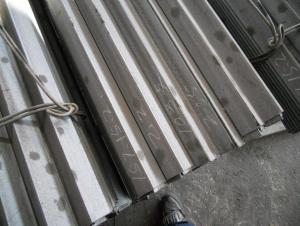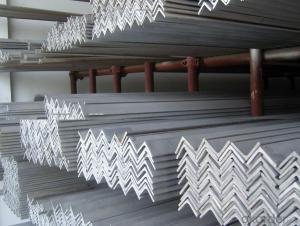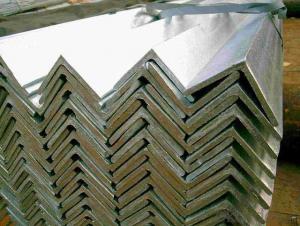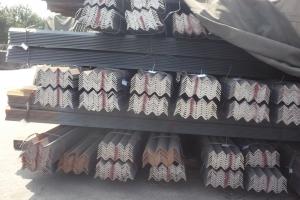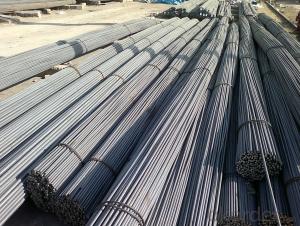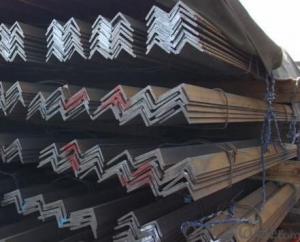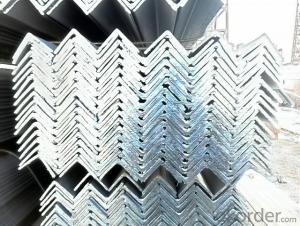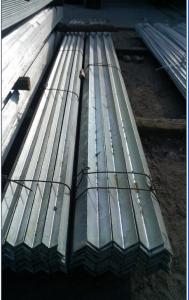Structure Steel Angle Bar Made In China Q235 JIS GB
- Loading Port:
- Tianjin
- Payment Terms:
- TT OR LC
- Min Order Qty:
- 25 m.t.
- Supply Capability:
- 40000 m.t./month
OKorder Service Pledge
OKorder Financial Service
You Might Also Like
Specification
Product Description:
OKorder is offering Structure Steel Angle Bar Made In China Q235 JIS GB at great prices with worldwide shipping. Our supplier is a world-class manufacturer of steel, with our products utilized the world over. OKorder annually supplies products to European, North American and Asian markets. We provide quotations within 24 hours of receiving an inquiry and guarantee competitive prices.
Product Applications:
Structure Steel Angle Bar Made In China Q235 JIS GB are ideal for structural applications and are widely used in the construction of buildings and bridges, and the manufacturing, petrochemical, and transportation industries.
Product Advantages:
OKorder's Structure Steel Angle Bar Made In China Q235 JIS GB are durable, strong, and resist corrosion.
Main Product Features:
· Premium quality
· Prompt delivery & seaworthy packing (30 days after receiving deposit)
· Corrosion resistance
· Can be recycled and reused
· Mill test certification
· Professional Service
· Competitive pricing
Product Specifications:
Specifications of Structure Steel Angle Bar
1.Invoicing on theoretical weight or actual weight as customer request
2.Standards:GB,ASTM,BS,AISI,DIN,JIS3.Material:GBQ235B,Q345BorEquivalent;ASTMA36;EN10025,S235JR,S355JR;JISG3192,SS400;SS540.
4.Sizes:
EQUAL ANGLES SIZES |
| ||
a(mm) | a1(mm) | thickness(mm) | length |
25 | 25 | 2.5---3.0 | 6M/12M |
30 | 30 | 2.5---4.0 | 6M/12M |
38 | 38 | 2.5 | 6M/12M |
38 | 38 | 3.0---5.0 | 6M/12M |
40 | 40 | 3.0---6.0 | 6M/12M |
50 | 50 | 3 | 6M/12M |
50 | 50 | 3.7---6.0 | 6M/9M/12M |
60 | 60 | 5.0---6.0 | 6M/9M/12M |
63 | 63 | 6.0---8.0 | 6M/9M/12M |
65 | 65 | 5.0---8.0 | 6M/9M/12M |
70 | 70 | 6.0---7.0 | 6M/9M/12M |
75 | 75 | 5.0---10.0 | 6M/9M/12M |
80 | 80 | 6.0---10.0 | 6M/9M/12M |
90 | 90 | 6.0---10.0 | 6M/9M/12M |
100 | 100 | 6.0---12.0 | 6M/9M/12M |
120 | 120 | 8.0-12.0 | 6M/9M/12M |
125 | 125 | 8.0---12.0 | 6M/9M/12M |
130 | 130 | 9.0-12.0 | 6M/9M/12M |
140 | 140 | 10.0-16.0 | 6M/9M/12M |
150 | 150 | 10---15 | 6M/9M/12M |
160 | 160 | 10---16 | 6M/9M/12M |
180 | 180 | 12---18 | 6M/9M/12M |
200 | 200 | 14---20 | 6M/9M/12M |
5. Material details:
Alloy No | Grade | Element (%) | |||||
C | Mn | S | P | Si | |||
|
|
|
|
|
|
| |
Q235 | B | 0.12—0.20 | 0.3—0.7 | ≤0.045 | ≤0.045 | ≤0.3 | |
|
|
|
|
|
|
| |
Alloy No | Grade | Yielding strength point( Mpa) | |||||
Thickness (mm) | |||||||
≤16 | >16--40 | >40--60 | >60--100 | ||||
≥ | |||||||
|
|
|
|
|
| ||
Q235 | B | 235 | 225 | 215 | 205 | ||
Alloy No | Grade | Tensile strength (Mpa) | Elongation after fracture (%) | ||||
Thickness (mm) | |||||||
| ≤16 | >16--40 | >40--60 | >60--100 | |||
≥ | |||||||
|
|
|
|
|
|
| |
Q235 | B | 375--500 | 26 | 25 | 24 | 23 | |
Usage & Applications of Structure Steel Angle Bar
According to the needs of different structures, Angle can compose to different force support component, and also can be the connections between components. It is widely used in various building structures and engineering structures such as roof beams, bridges, transmission towers, hoisting machinery and transport machinery, ships, industrial furnaces, reaction tower, container frame and warehouse etc.
FAQ:
Q1: Why buy Materials & Equipment from OKorder.com?
A1: All products offered byOKorder.com are carefully selected from China's most reliable manufacturing enterprises. Through its ISO certifications, OKorder.com adheres to the highest standards and a commitment to supply chain safety and customer satisfaction.
Q2: How do we guarantee the quality of our products?
A2: We have established an advanced quality management system which conducts strict quality tests at every step, from raw materials to the final product. At the same time, we provide extensive follow-up service assurances as required.
Q3: How soon can we receive the product after purchase?
A3: Within three days of placing an order, we will begin production. The specific shipping date is dependent upon international and government factors, but is typically 7 to 10 workdays.
Q4: What makes stainless steel stainless?
A4: Stainless steel must contain at least 10.5 % chromium. It is this element that reacts with the oxygen in the air to form a complex chrome-oxide surface layer that is invisible but strong enough to prevent further oxygen from "staining" (rusting) the surface. Higher levels of chromium and the addition of other alloying elements such as nickel and molybdenum enhance this surface layer and improve the corrosion resistance of the stainless material.
Q5: Can stainless steel rust?
A5: Stainless does not "rust" as you think of regular steel rusting with a red oxide on the surface that flakes off. If you see red rust it is probably due to some iron particles that have contaminated the surface of the stainless steel and it is these iron particles that are rusting. Look at the source of the rusting and see if you can remove it from the surface.
Images:
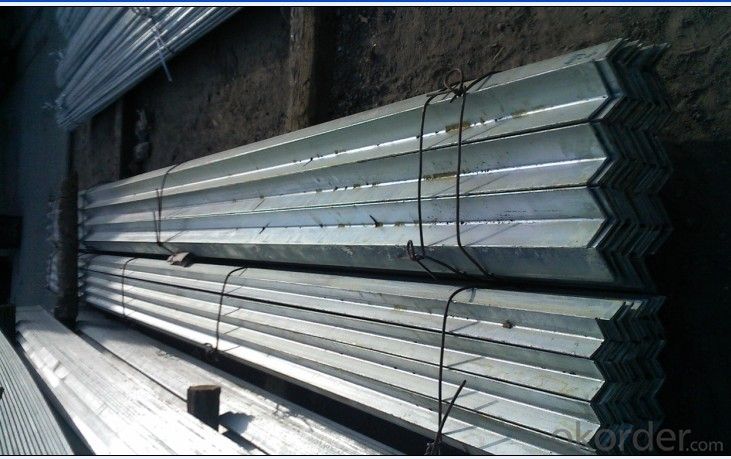
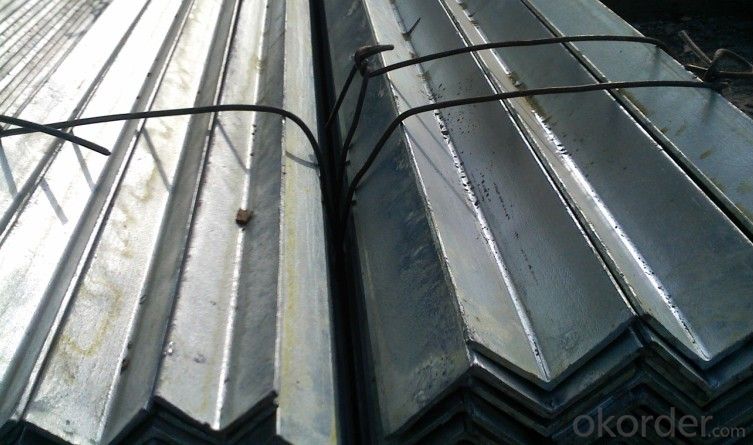
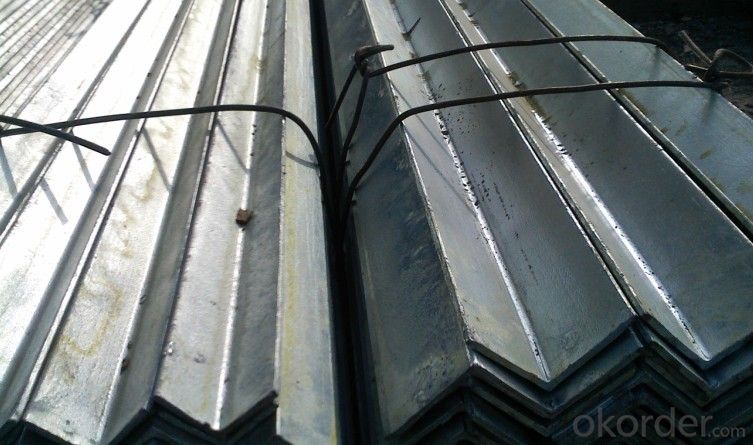
- Q: What are the standard specifications for steel angles?
- The standard specifications for steel angles are defined by various organizations, including the American Society for Testing and Materials (ASTM) and the International Organization for Standardization (ISO). These specifications ensure that steel angles meet certain quality and dimensional requirements. One of the most commonly used specifications for steel angles is ASTM A36, which covers carbon structural steel shapes. According to this specification, steel angles should have a minimum yield strength of 36,000 psi (pounds per square inch) and a minimum tensile strength of 58,000 to 80,000 psi. The dimensions of the angles are specified in terms of leg length, thickness, and angle size, which can range from 1/2 inch to 8 inches. Another widely used specification is ASTM A572, which covers high-strength low-alloy structural steel shapes. Steel angles under this specification should have a minimum yield strength of 50,000 psi and a minimum tensile strength of 65,000 to 80,000 psi. The dimensions of the angles are similar to ASTM A36. ISO also provides standards for steel angles, such as ISO 657-1 and ISO 657-5. These standards specify dimensions, tolerances, and technical requirements for hot-rolled steel angles. ISO 657-1 covers general purpose angles, while ISO 657-5 covers unequal leg angles. In addition to these standards, steel angles may also be subject to specific requirements based on their intended application or industry. For example, angles used in construction or engineering projects may need to meet additional specifications set by local building codes or design guidelines. It is important to consult the relevant standards and specifications to ensure that steel angles meet the necessary requirements for a particular application, as these standards help ensure the quality, strength, and dimensional accuracy of the angles.
- Q: What is the maximum length of a steel angle that can be transported?
- The maximum length of a steel angle that can be transported depends on various factors such as the transportation method, the size and weight restrictions of the vehicle used, and any legal limitations imposed by local regulations. However, in general, steel angles are commonly transported in lengths ranging from 20 to 40 feet, which are standard sizes for shipping containers and flatbed trucks.
- Q: How does the price of steel angles vary based on size and grade?
- The price of steel angles varies based on size and grade, with larger sizes and higher grades typically commanding higher prices.
- Q: How do steel angles perform in terms of electrical conductivity?
- Steel angles have low electrical conductivity due to the high resistance of steel to the flow of electric current.
- Q: What's the size of the 50 angle iron?
- Is the grading angle and side angle and side angle, it has three sides, say according to the above 50*50*3, this is an equal angle on both sides, tianxiangcheng, 50mm, high 3mm.
- Q: What are the advantages of using steel angles over other materials?
- Using steel angles offers several advantages over other materials. Firstly, steel angles are renowned for their superior strength and durability. Steel is an exceptionally robust material capable of withstanding heavy loads and extreme weather conditions. As a result, steel angles are ideal for critical structural applications, such as building construction and bridge supports, where strength and stability are paramount. Secondly, steel angles provide excellent design and fabrication versatility. They can be effortlessly cut, welded, and shaped into various sizes and forms, allowing for customized solutions that perfectly match specific project requirements. This adaptability makes steel angles suitable for a wide range of applications, including frameworks, support brackets, and reinforcements. Furthermore, steel angles possess high corrosion resistance. Steel inherently resists rusting and can be further shielded through diverse coatings or galvanization processes. This corrosion resistance ensures the long lifespan and low maintenance of steel angles, making them a cost-effective choice in the long run. Additionally, steel angles offer a remarkable level of fire resistance. Steel does not burn or contribute to fire propagation, making it particularly valuable in applications where fire safety is a concern, such as building structures or industrial facilities. Lastly, steel angles are readily available and cost-effective. Steel is one of the most widely utilized materials in the construction industry and can be easily obtained in various sizes and grades. The abundance of steel makes it an economical option, especially when compared to alternative materials with limited availability or higher manufacturing costs. In conclusion, the advantages of using steel angles encompass their strength, versatility, corrosion resistance, fire resistance, and cost-effectiveness. These characteristics establish steel angles as the preferred choice for numerous construction and structural applications.
- Q: Can steel angles be used for manufacturing decorative brackets?
- Yes, steel angles can be used for manufacturing decorative brackets. Steel angles are versatile and can be easily fabricated into various shapes and sizes, making them suitable for creating decorative brackets. The angles can be cut, welded, and formed into different designs to achieve the desired aesthetic appeal. Furthermore, steel angles offer strength and durability, ensuring that the decorative brackets can support the weight of the objects they hold. Whether it is for architectural purposes or home décor, steel angles provide a reliable and cost-effective option for manufacturing decorative brackets.
- Q: Can steel angles be used for shelving?
- Yes, steel angles can be used for shelving. Steel angles are commonly used in shelving systems as they provide strength, stability, and durability. They can be easily mounted on walls or used as supports for shelves, making them ideal for various storage applications.
- Q: What are the common methods of joining steel angles together?
- There exist various methods for connecting steel angles together. 1. Welding is a well-liked technique employed to join steel angles. This involves the melting of the angle edges, followed by cooling and solidification to establish a robust bond. Welding can be executed using diverse approaches like arc welding, MIG welding, or TIG welding. 2. Bolting is yet another frequent method used for joining steel angles. It entails using bolts, nuts, and washers to secure the angles in place. This technique permits easy dismantling and reassembly, if necessary. Bolts are typically utilized in combination with gusset plates or brackets to provide added strength and stability. 3. Riveting is a conventional method of connecting steel angles. It necessitates the usage of a rivet, a cylindrical metal pin, to hold the angles firmly. The rivet is inserted into pre-drilled holes in the angles and then deformed on one end to create a head, thereby securing the angles together. 4. Adhesive bonding is a technique that utilizes a specialized adhesive to connect steel angles. The adhesive is applied between the angles, and pressure is exerted to ensure a sturdy bond. Adhesive bonding is often employed in situations where a clean and visually appealing joint is desired. 5. Mechanical fasteners, such as screws, nails, or self-tapping screws, can also be employed to join steel angles. These fasteners are inserted into pre-drilled holes to establish a secure connection. However, they may not possess the same level of strength as other methods like welding or bolting. When selecting the appropriate method for joining steel angles, it is crucial to consider the specific requirements of the application, including load-bearing capacity, aesthetics, and ease of disassembly.
- Q: What is the typical thickness of the legs of a steel angle?
- The typical thickness of the legs of a steel angle can vary depending on the specific application and structural requirements. However, in general, the thickness of steel angle legs can range from 1/8 inch to 3/4 inch.
Send your message to us
Structure Steel Angle Bar Made In China Q235 JIS GB
- Loading Port:
- Tianjin
- Payment Terms:
- TT OR LC
- Min Order Qty:
- 25 m.t.
- Supply Capability:
- 40000 m.t./month
OKorder Service Pledge
OKorder Financial Service
Similar products
Hot products
Hot Searches
Related keywords
